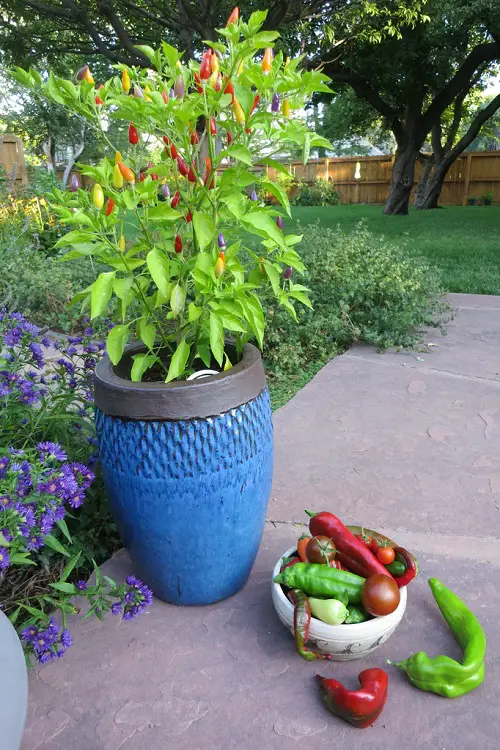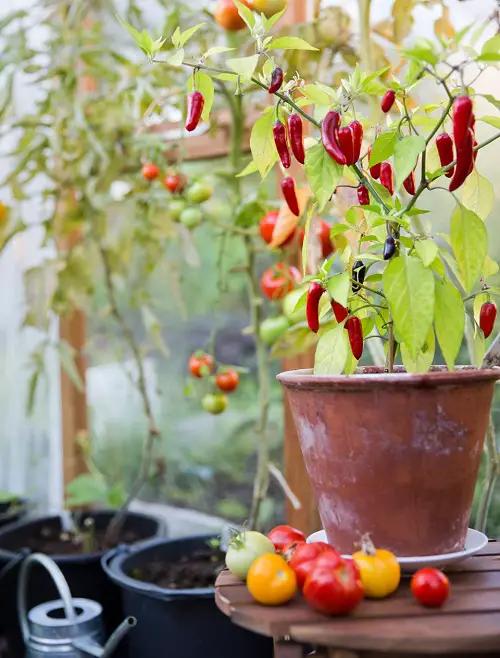Learn the best Secrets to Grow More Peppers Than Ever and enjoy and hot and bountiful harvest all year round!
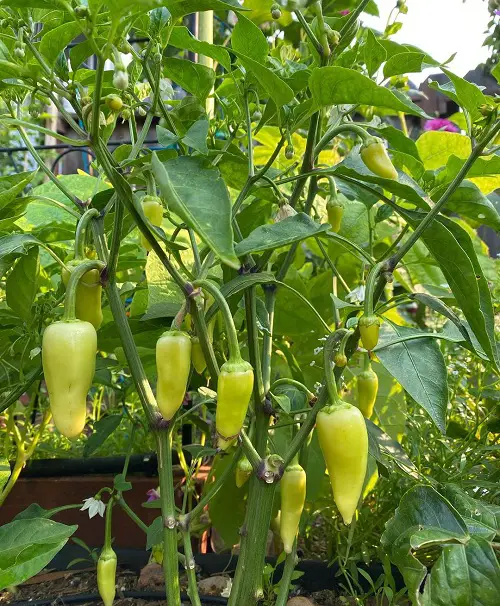
Peppers can be a fantastic addition to your kitchen garden to add that touch of spice to many dishes. If you want to grow the best ones, then follow these Secrets to Grow More Peppers Than Ever!
Learn Growing Bell Peppers in Pots and Containers here
Ideal Growing Conditions for Peppers
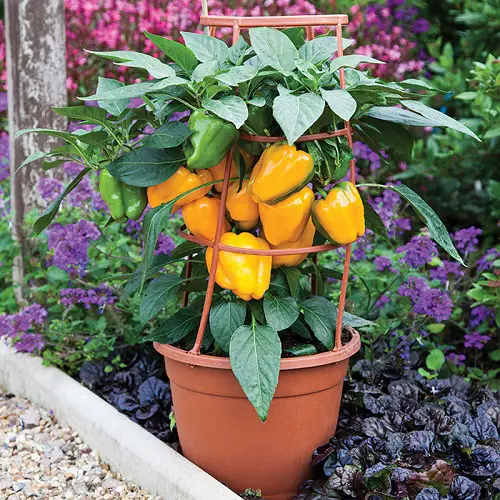
Although some may consider pepper cultivation to be effortless, potential problems can still emerge if the environment is not ideal. Peppers thrive in temperatures between 60-90 Fahrenheit (15-33 Celsius).
Temperature is one of the most crucial factors while growing peppers, and you can manage it by growing them in pots.
Put These 12 Things in Your Pepper Planting Hole For the Best Growth
Secrets to Grow More Peppers Than Ever
Whether you prefer sweet or hot pepper varieties, there are specific guidelines to follow when growing them.
1. Germinate Pepper Seeds with This Trick
Pepper seeds need specific conditions for successful germination. To speed up the process and increase the success rate of germination, try using a thick paper towel.
- Dampen the towel, place the pepper seeds inside, and put the whole thing in a plastic bag in a warm place, such as the top of the fridge or a kitchen countertop.
- Once the seeds start to sprout, plant them in separate pots.
Here are some fantastic tips to make pepper hotter
2. Plant Peppers in the Right Area
Hot peppers need ample exposure to sunlight for optimal growth and productivity, as their fiery and piquant flavor profiles depend on it. Without sufficient sunlight, they may become stunted and less productive.
Peppers thrive in full sun and require approximately 6-8 hours of direct sunlight daily. Avoid keeping them in the shade, as it will result in fewer peppers with less or no spiciness.
3. Use Quality Soil
Instead of using regular garden soil to grow peppers, it would be a good idea to amend the growing medium with compost, peat moss, or well-rotted manure.
A light, airy soil mix works best, as peppers do not like to have their roots standing in water. Good drainage is key, so make sure the soil is not too heavy or dense. Also, do ensure that the pH stays between 6.0-7.0.
Learn How to Check Your Soil pH at Home here
4. Use Epsom Salt
Epsom salt is the magic potion that you must use while growing peppers.
Epsom salt is hydrated magnesium sulfate; it contains 10 percent Magnesium and 13 percent Sulfur. It helps in chlorophyll development, in photosynthesis, and boosts the plant’s growth and resistance to diseases.
Its application reduces slow growth, makes the pepper plants healthier, lusher, and greener than before (due to the boost in chlorophyll production), and induces larger and tastier fruits.
Add 1 tablespoon of Epsom salt to a gallon of water and pour it around the base of your pepper plant. Religiously do this once every 4-5 weeks and watch your plants thrive! It is one of the best Secrets to Grow More Peppers Than Ever.
Here are the advantages of using Epsom Salt for Peppers
5. Use the Right Level of Nitrogen
According to a study published by the University of California, Higher nitrogen levels seem to increase for higher productivity and increased heat.
Here are Signs that Show Your Plants Need Nitrogen
6. Planting and Hardening Off
For the proper development of plants, gradually expose the seedlings to their new environment. Abruptly transferring delicate plants from indoors to the garden can be too harsh for them.
- To begin hardening off your seedlings, take your tray(s) outside when the daytime temperature reaches the mid-60s.
- Position them near a warm spot on the edge of your house or garage for a few hours each afternoon for the next 3-4 days.
- When bringing them in and out, make sure to avoid leaving them outside overnight and gradually increase their outdoor exposure time.
By following these guidelines, you can set your pepper plants up for success and promote optimal growth in their new outdoor environment.
7. Water the Plants Correctly
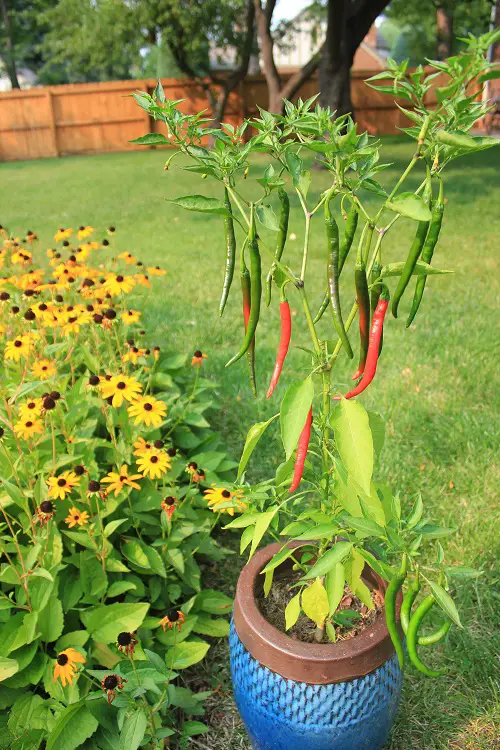
The best way to kill these plants is to water them daily.
Allow the top inch of soil to become dry before watering again. This helps the plant’s roots to grow deeper, which makes them more resistant to drought.
Also, avoid spilling the water on the foliage to keep it safe from potential diseases.
Learn How To Water Plants While Away here
8. Mulching
Mulching can be an effective way to prevent weed growth and minimize moisture loss from the soil surface, which is crucial for optimal pepper growth.
The best way to mulch pepper plants is to use a 2–3 inch layer of organic mulch such as straw, wood chips, or compost.
Make sure to keep the mulch away from the stems of the plants, as it can cause them to rot.
9. Don’t Forget Companion Planting
One way to enhance the growth of your bell peppers is through companion planting.
- Spinach: It grows easily alongside peppers and helps to repel pests.
- Carrots: Carrots and peppers make a great companion planting duo. The carrots attract beneficial predatory insects that can help keep pests away from the peppers.
- Onions: They help ward off pests from the pepper plants.
- Basil: Basil is a great companion for pepper plants as it helps to repel some pests and can also add flavor to dishes made with peppers.
- Marigolds: Marigolds are a great companion for pepper plants as they help to repel nematodes and other pests.
- Garlic: It can be planted near pepper plants to repel pests and also add flavor to dishes made with peppers.
10. Pinch Off the First Pepper Blooms
Pinching off pepper flowers can help to improve the overall health of the plant by removing old and diseased flowers. It also encourages the plant to produce more flowers, as well as larger and healthier fruits.
Additionally, it can help to prevent the spread of disease from old flowers to new ones.
Finally, it can help to promote air circulation and light penetration, resulting in better photosynthesis and improved overall plant health.
Note: By pinching off the top tip, it helps to encourage the plant to produce more side shoots and branches, which in turn can lead to a greater yield of peppers. Additionally, pinching off the top tip of the pepper when it is young can also prevent the plant from becoming too tall and leggy and can help to keep the pepper plant’s foliage more compact and manageable.
11. Harvest at the Right Time
To know if a pepper is ready to harvest, look for signs of ripeness, like color changes from green to red, yellow, orange, or other colors depending on the variety. Other signs of ripeness include a glossy or waxy texture and a fragrant aroma.
Peppers that are ready to harvest will be firm when squeezed.
Pepper is usually ready to harvest around 60 to 90 days after planting, depending on the variety.
Learn When to Plant Green Peppers in Florida here
Here are the advantages of harvesting peppers at the right time:
- Higher yields: Harvesting peppers at the right time ensures that the plant produces its fullest yield, so you get the most out of your efforts.
- Better quality: Peppers that are harvested too early or too late may not have the best flavor and texture, but harvesting them at the right time ensures that you get the best quality peppers.
- Faster ripening: It encourages the remaining peppers on the plant to ripen faster, so you can enjoy them sooner.
- Reduced pest damage: It reduces the likelihood of them being damaged by pests, so you get the full benefit of your crop.


